Keeping weird and exotic fish species has become a trend in the modern aquarium trade. If you are an aquarist that loves to adopt unique fish in your aquarium, blind cave tetra is a fish species worth looking at.
Blind Cave Tetra is a unique and exciting fish that deserves the best care possible. This article will guide you through how to care for blind cave tetras properly.
You will learn about what blind cave tetras need, as well as the difficulties they experience in their natural habitat.
We hope this article helps you take better care of your blind cave tetra!
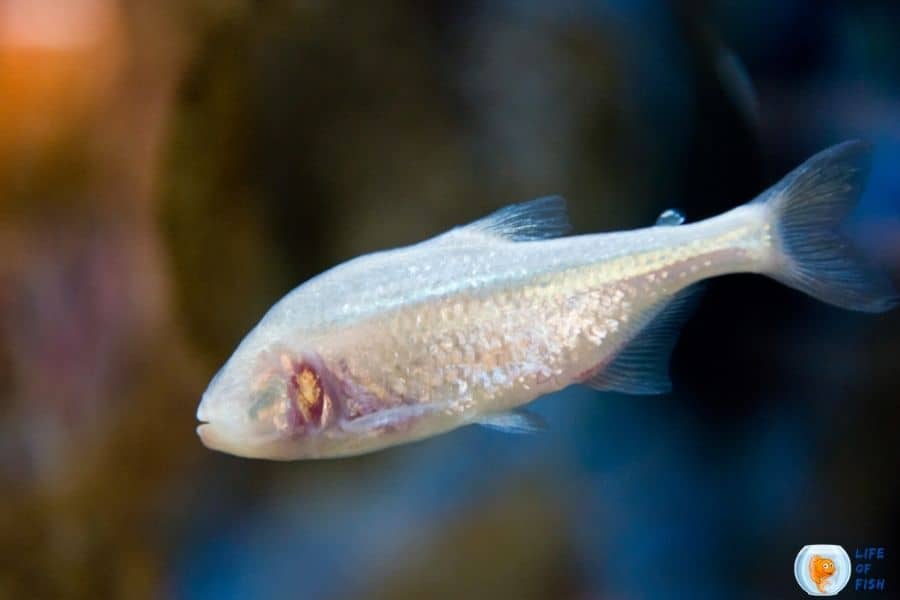
What is blind cave tetra?
Jump To
- 1 What is blind cave tetra?
- 2 Blind cave tetra appearance
- 3 Are Blind cave fish blind?
- 4 Are blind cave tetras difficult to care for?
- 5 How big do blind cave tetra get?
- 6 Is blind cave tetra aggressive?
- 7 Blind cave tetra behavior
- 8 How long do blind cave tetras live?
- 9 Blind cave tetra care
- 10 Blind cave tetra breeding
- 11 Special tips
- 12 How to feed blind cave tetra?
- 13 Blind cave tetra tank mates?
- 14 How do blind cave tetras “see” obstacles?
- 15 Blind cave tetra Price
- 16 Conclusion
Scientifically known as Astyanax mexicanus, this blind variant is a blind and serene fish found in South America.
Also known as Mexican tetra, there are two subspecies of Blind cave tetra. One of them is distributed in Mexico and into Gauthamala.
The other species are found only in Mexico. The most significant distinction between the two subspecies is that one is blind while the other is not.
The species that is blind inhabit underground caves and crevices while the other one dwells on the surface of the water in fast-flowing streams, rivers, ponds, and lakes.
The one we specifically talk about in this article is the blind fish that live in caves or crevices.
In the wild, they live blind and serenely in caves or crevices, which can be as small as 1 cm (0.8 inches) across to over 3 m (10 feet) wide and up to 15 cm (6 inches) high, with temperatures usually around 23°C-25°C (73°F-77°F).
Blind cave tetra appearance
Appearance-wise, blind cave tetras exhibit albino coloration and transparent fins. They do not have eyes and will have a pinky color with iridescent sheen as they get older.
These fish do not grow more than 4 inches in length. Their skin is covered with a layer of scales and mucus to reduce dragging and infection.
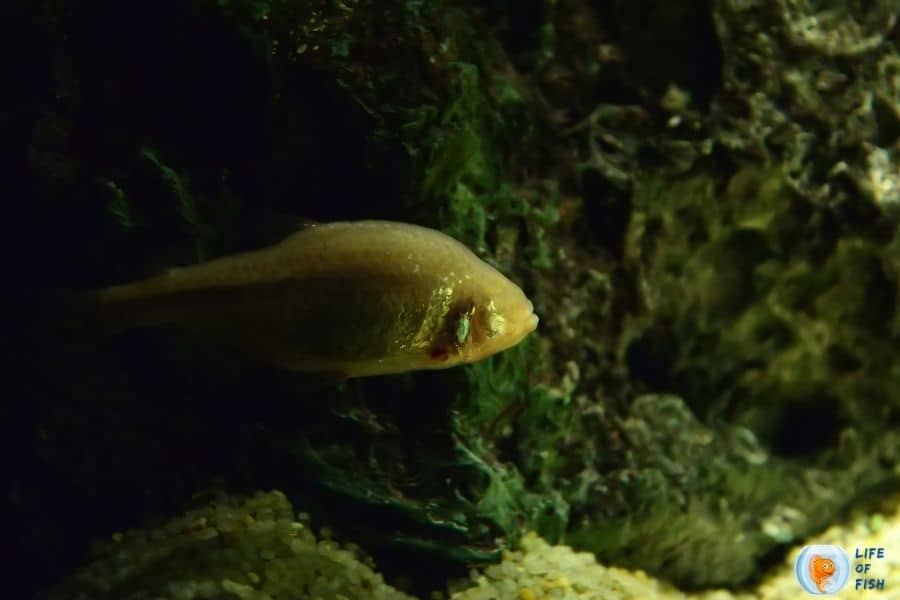
Are Blind cave fish blind?
The blind subspecies are blind, but the other subspecies of this genus are not blind.
The blind cave tetra is not always completely blind, but it often slowly loses sight after hatching.
Different populations of this fish have different levels of blindness – some can see up to an extent.
In contrast, others lose all viewable light from their eyes and become totally reliant on other senses such as sound or smell for navigation through the darkness.
One example is found in the Micos Cave, where a population has limited vision. However, another group living in Pachon Caves is completely sightless; these are called “blind fish.”
Are blind cave tetras difficult to care for?
You may think that these fish are difficult to care for, but blind cave tetras are actually very easy to care for.
They will not see their surroundings due to living in dark caves, but Mexican Tetra care is still like other fish, except the blind cave fishes live in a different habitat with lower lighting and temperature conditions.
How big do blind cave tetra get?
Blind cave tetras can reach up to four inches in length, and they live in schools.
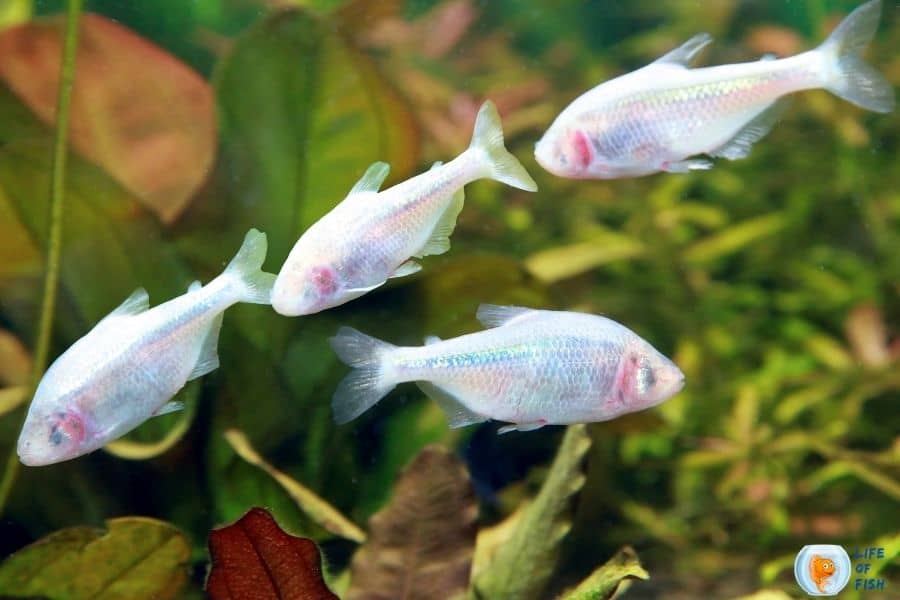
Is blind cave tetra aggressive?
Blind cave tetras are not aggressive. They are a fairly peaceful species that live in large schools.
However, they may nip at other fish, thinking of them as food. But, when they realize that it’s not food, they stop nibbling at the other fish.
Blind cave tetra behavior
Since the natural habitats of blind cave tetra are deep caves and crevices, these fish prefer to live in similar environmental conditions.
They mostly live under caves in low-light conditions. In aquariums, these fish rarely swim into the tank sides, decorations, and other tankmates.
Blind cave tetras live in schools. If they are not used to other fish, they may nip at other fish when introduced.
But, this is not aggressive behavior. Since they are blind, they think of new fish as food. Once they learn the other fish are not food, they stop nipping.
Blind cave tetras will eat anything that falls onto the ground. They do well on sinking food but will also root in the substrate for food.
A specially evolved sensory organ known as the “lateral line” helps these fish find food and avoid obstacles in the water by detecting pressure and vibrations in the water.
How long do blind cave tetras live?
Blind cave tetras live for about three to five years under optimum care conditions.
Blind cave tetra care
They are easily cared for and can be perfect pets for an aquarium of any size, as long as the tank is at least 20 gallons.
Blind cave tetra is a blind species of fish that inhabits deep caves and crevices.
These tetras prefer living under low light conditions, which makes them an exciting addition to any aquarium.
Blind cave tetra size
Mexican Tetra is a larger tetra species that grow up to four inches long and live in schools.
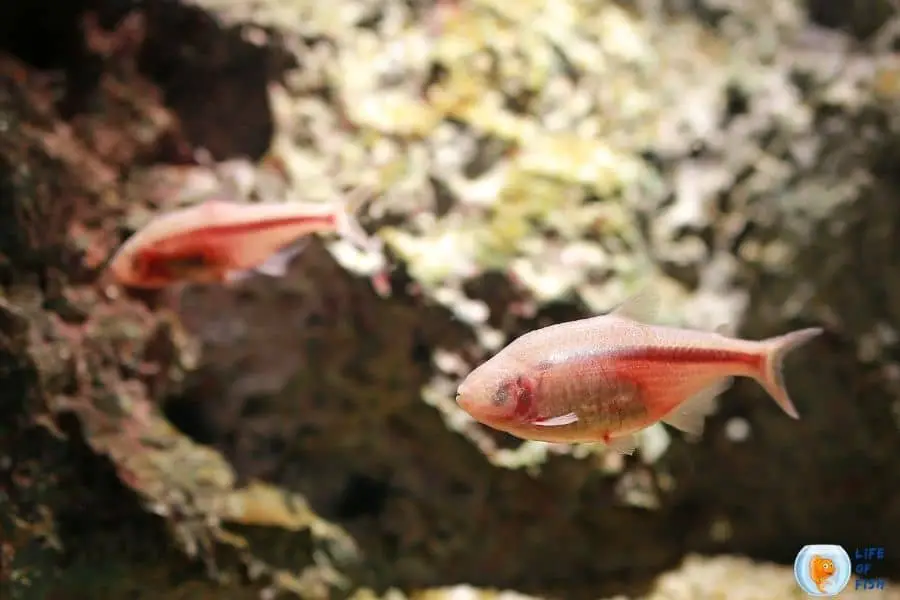
Blind cave tetra tank size
These fish species need at least a 20-gallon tank for a school of five.
How many blind cave tetra should be kept together?
Since these are schooling fish, you should keep at least five tetras together in an aquarium.
Tank setup
Setting up a tank for blind cave tetra is relatively easy than for other fish species.
As these are blind fish species, you should keep the decorations at a minimum to avoid the blind fish from getting hurt.
As their natural habitats consist of caves, crevices, and darker environments, these fish prefer similar conditions in the aquarium.
Some people keep them in a planted aquarium, but I would recommend creating an environment based on their natural habitat: dark and clear water.
Substrate
For substrate, we recommend adding soft sand or fine gravel. These are primarily middle-dwelling fish that are root substrates for food.
So, you should avoid coarse substrate to prevent injuries.
Decorations
You should decorate the tank sparsely with caves, flat rocks, and pieces of driftwood.
When decorating the tank, keep in mind that blind cave tetras are blind and do not do well with more obstacles. So, keep the decorations at a minimum level.
Plants
Plants are not part of the blind cave tetra’s natural habitats. So, keeping plants is not recommended.
However, if you wish to keep higher oxygen levels and a cleaner tank, you can add free-floating plants to your tank.
Lightings
Blind cave tetras live in dark environments. So, it is necessary to provide a darker habitat for these species.
Since it is not practical to keep out lights in an aquarium, you can keep lightings on the bottom at a minimum level.
And also, providing some caves will help these fish to relax under darker conditions.
Filtration and other equipment
Just like any other fish, these fish require cleaner water to thrive. So, you will have to install a sound filtration system in the tank.
Additionally, you will have to add a water heater to the tank if you live in a cold area. These fish prefer a warmer temperature of about 20°C to 25°C in the water.
Water quality condition
Blind cave tetras require specific water conditions in order to thrive.
As they inhabit deep caves underwater, the water conditions in these areas are different than surface water.
These fish species require particular pH levels and specific hardness levels for thriving well in the aquarium.
The pH of the Mexican Tetra tank should be between 6.5 to 8, while the total hardness of the water should be around 30 dGH.
The Mexican Tetra prefers water that is neither too acidic nor overly basic.
The water temperature should be warmer of about 20°C to 25°C (68°F to 77°F). So, if you live in a cold climate, be sure to provide an aquarium water heater in your aquarium.
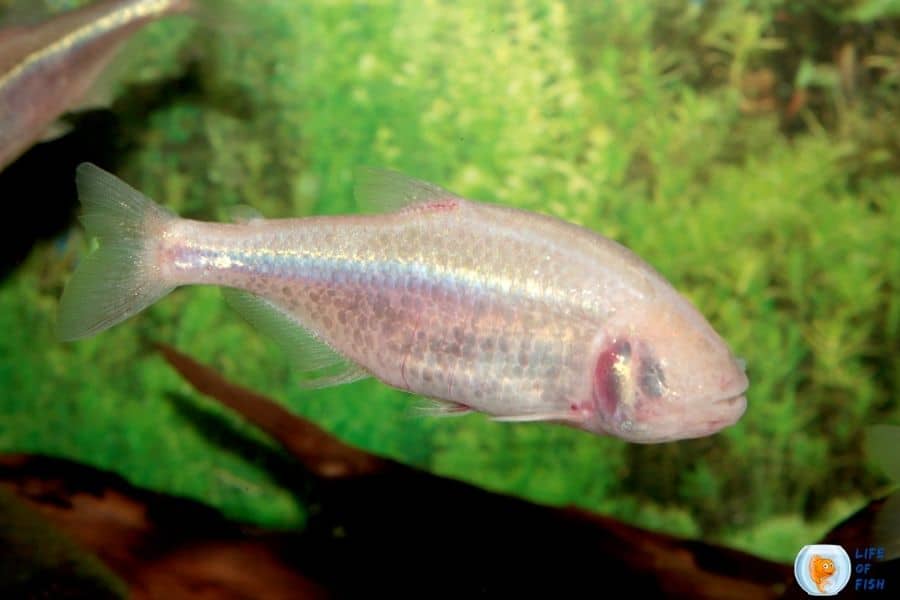
Blind cave tetra breeding
Breeding of Mexican Tetra is incredibly easy in captivity if the environment is to their liking.
However, finding male and female fish is challenging because it is nearly impossible to tell the difference between them.
If you wish to breed blind cave tetra, it is best to keep a single school of these freshwater fish, and for this reason, we recommend keeping at least six blind cave tetras together in order to increase the chances of breeding.
To breed blind cave tetras, provide an environment similar to their natural habitats, as we explained above.
since it is difficult to identify the sexes of these fish, your best bet is to let them pair off naturally.
Blind cave tetras are egg layers.
When the species spawns and lays its eggs, it does so on the bottom of the tank, so add some aquatic moss or stretch a length of mesh across the aquarium to keep the eggs safe until they hatch.
Blind cave tetra fry care
It takes around 24 hours for the fertilized eggs to hatch. The fry will remain in the egg sac for another 5 to 7 days feeding off the yolk sack.
Then, you will have to feed them with fry food such as baby brine shrimp.
Did you know? Blind cave tetra fry has fully developed eyes, but they degenerate and are reabsorbed in the first few weeks of life.
When the fish is in “full” cave form, it becomes “blind” and completely lacks pigmentation.
Special tips
The blind cave tetra, in its pale color body, creates an even more spectacular effect as it shines brightly against the radiance of the bioluminescent light.
For this, we recommend, Aqueon flexible LED aquarium bubble wand in your aquarium.
How to feed blind cave tetra?
Blind cave tetras are omnivore fish species. In the wild, blind cave tetras feed on small insects, black worms and crustaceans. In captivity, they will accept any food you offer.
As Mexican tetras cannot hunt for food, you will have to provide them with a nutritious diet.
For this reason, we recommend you to feed blind cave tetras high-quality flake food, frozen foods or pellets specifically designed for omnivore fish species.
However, these freshwater fish will also accept fresh food, frozen foods, and freeze-dried food such as bloodworms, blackworms, brine shrimp, and tubifex.
So, in addition to pellets and flakes, supplement them with protein-rich food for the better health of these fish.
When choosing fish food, it is always better to choose “sinking fish food” as totally blind cave tetras rarely come to the water’s surface, even for feeding.
They mainly feed while the food is sinking and from the bottom.
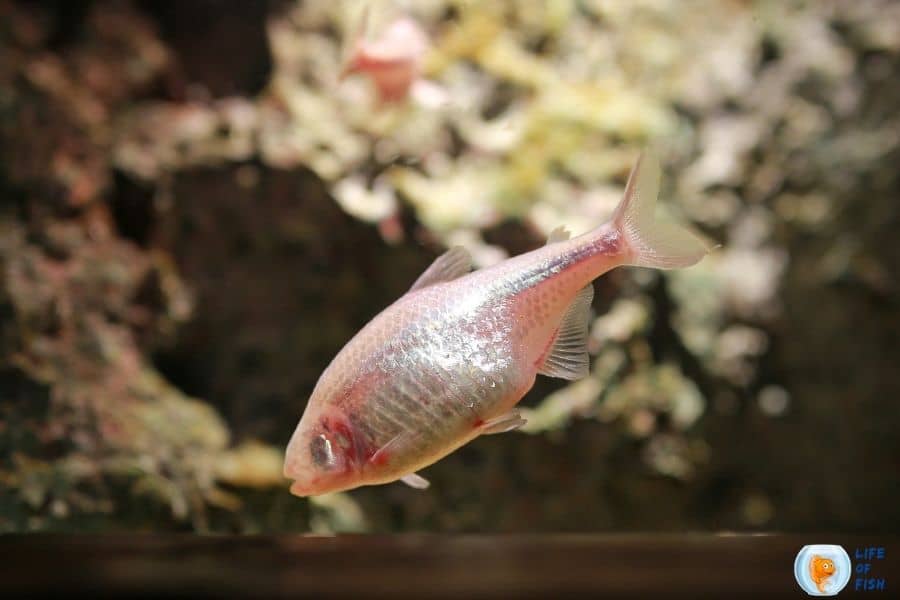
Blind cave tetra tank mates?
You can keep blind cave form in community tanks or species tanks, but make sure that no other fish species live in your aquarium, which could be competitors for blind cave tetra’s food.
Further, avoid keeping these fish with aggressive fish species as they can bully these fish easily.
Blind cave tetras are nippy at times, so you may have to avoid fish that have long, flowing fins.
Suitable tankmates are peaceful fish species that occupy different water levels and have relatively the same water parameter requirements. Some suitable tank mates are,
- Tetras
- Barbs
- Gouramis
- Corydoras catfish
Additionally, avoid adding large carnivore fish species with blind cave tetras as they easily become prey for those fish.
Related Questions
How do blind cave tetras “see” obstacles?
Although blind cave tetras do not have “eyes” to “see” things, they use a technique similar to echolocation to sense their surroundings.
They have receptors on the skin called “lateral line,” which helps them detect movement, pressure, and vibrations in the water.
This way, blind cave tetra’s are able to sense objects without having eyesight.
Further, according to a study by Tel Aviv University in Israel, these fish produce bursts of suction by puckering their mouth, which helps them to “see” obstacles on their way.
As scientists explain, this is a unique form of navigation seen only in blind cave tetras.
Blind cave tetra Price
In general, the price of blind cave tetra is around $10 to $25 for a small school.
Conclusion
Because of the blindness of blind cave tetras, many aquarists think that blind cave tetras are very difficult to care for.
But as we have discussed, blind cave tetra is a hardy fish species, and it can adapt itself well in any tank environment with proper water parameter requirements.
So, if you don’t have much time to maintain and care for your aquatic life and still want to keep exotic fish species, the blind cave tetra is a beautiful cavefish that can be easily kept in an aquarium.
Read Next: Fin Rot In Guppies | 10 Simple (But Important) Things To Remember |
